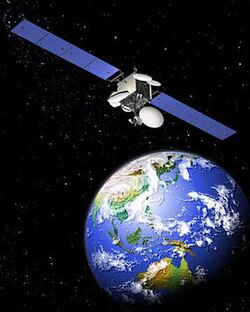MEASAT
From Wikipedia, the free encyclopedia

MEASAT (Malaysia East Asia Satellite) is the name of a line of Malaysian communications satellites owned and operated by MEASAT Satellite Systems Sdn. Bhd. (MYX: 3875, formerly Binariang Satellite Systems Sdn. Bhd.). As of 2006, the MEASAT satellite network consists of three geostationary satellites designed and built by Boeing Satellite Development Center (formerly Boeing Satellite Systems). MEASAT-1 and MEASAT-2 were launched in 1996 and MEASAT-3 in 2006.
The MEASAT-1 and 2 satellites were designed to provide 12 years of both direct-to-user television service in Malaysia and general communications services in the region from Malaysia to the Philippines and from Beijing to Indonesia. With the launch of MEASAT-3, the coverage extends even further to an area encompassing 70% of the worlds population.
Contents[hide] |
[edit] MEASAT-1 and MEASAT-2
In May 1994, Binariang Sdn. Bhd. of Kuala Lumpur and Boeing Satellite Systems signed a contract calling for the construction of the Malaysia East Asia Satellite (MEASAT) system. The system called for one Boeing 376 model spacecraft, equipment for a satellite control station on Langkawi Island, and training of Malaysian spacecraft controllers. Binariang exercised its option for a second satellite in January 1995.
MEASAT 1 has five high-power transponders in Ku band for the direct-to-user service, powered by 112-watt traveling-wave tube amplifiers. The regional service is provided on 12 transponders in C band, using 12-watt solid state amplifiers. MEASAT-2 has 11 active transponders in Ku band. Eight of these use 95-watt traveling-wave amplifiers, and three have 62 watts. There also are six active transponders in C band, powered by 12-watt solid-state amplifiers.
As Boeing 376 spacecraft, the MEASAT satellites have three enhancements over the standard model. They were the first in the Boeing 376 series to be fitted with gallium arsenide solar cells, which deliver 40 percent more payload power as compared to their silicon predecessors. They were also the first Boeing 376s to use Boeing Satellite Systems' lightweight, high-gain shaped antenna. The satellites also used a more efficient bipropellant system for stationkeeping and attitude control maneuvers.
Both MEASAT-1 & 2 satellites were launched on Ariane rockets from Centre Spatial Guyanais at Kourou in French Guiana. MEASAT-1 was launched in January 1996, and MEASAT-2 was launched in November 1996. MEASAT-1 is located in a geostationary orbit at 91.5 degrees East, and MEASAT-2 is located in a geostationary orbit at 148 degrees East.
| Orbital Location | 91.5°East () |
| Geographic Coverage | South East Asia, northern Australia and Guam |
| Launch Year | 1996 |
| Present Status | Operational |
| Type of Satellite | Boeing 376 HP |
| Launch vehicle | Ariane 4 |
| Design Lifetime | 12 years |
| SSPA Power | 12 Watts |
| Transponder Bandwidth | 12×36MHz |
| Channel Polarization | Linear |
[edit] MEASAT-3
In March 2003, MEASAT Satellite Systems Sdn. Bhd. of Malaysia ordered a Boeing 601HP satellite, designated MEASAT-3. MEASAT-3 will join the existing Boeing-built MEASAT-1 and MEASAT-2 spacecraft in the Malaysia-East Asia Satellite (MEASAT) system.
International Launch Services was contracted as the launch provider. Boeing will also provide an upgrade to the MEASAT ground facilities in Malaysia, as well as training and launch support services.
MEASAT-3 was launched successfully on the 12th of December 2006, 7.35 am (Malaysian Time, GMT +8.00 HRS) from the Baikonur Cosmodrome, Kazakhstan [1]. The Launch Event in Kuala Lumpur, Malaysia, was held with the MEASAT-3 launch broadcasted live via satellite transmission.
The MEASAT-3 was launched on board an ILS service vehicle Proton M/Breeze M with a five-burn to orbit sequence. It entered commercial service on Jan 25th 2007 at a geostationary orbit of 91.5 degrees East (co-located with MEASAT-1). The C band and Ku band now covers geographically remote areas such as Sabah, Sarawak, and North India and expands the MEASAT fleet's coverage to more than 100 countries embracing Australia, Middle East, Eastern Europe and Africa.
MEASAT-3 transponders' specifications:
| EIRP (dBW) | 41 (Global beam), 45 (Asia beam) |
| G/T (dB/K) | +0.5 (Global beam), +2.8 (Asia beam) |
| TWTA power | 65 Watts |
| Transponder bandwidth | 24x36 MHz |
| Channel polarization | Linear |
| Frequency band | Uplink: 5,925-6,725 MHz Downlink: 3,400-4,200 MHz |
| EIRP (dBW) | 57 (Maximum) |
| G/T (dB/K) | +14 (Maximum) |
| TWTA power | 120 Watts |
| Transponder bandwidth | 24x36 MHz |
| Channel polarization | Linear |
| Frequency band | Uplink: 13.75-14.5 GHz Downlink: 10.95-12.75 GHz |









































0 comments:
Post a Comment